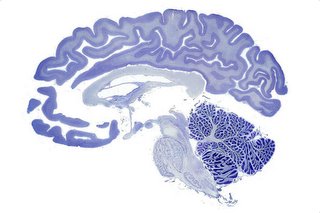De la guerre FHC - PJ
Something about the faculty of language must be unique in order to explain the differences between humans and other animals—if only the particular combination of mechanisms in FLB [Faculty of language in the Broad sense, i.e. au sens large]. We thus made the further, and independent, terminological proposal to denote that subset of FLB that is both specific to language and to humans as FLN. To repeat a central point in our paper: FLN [Narrow, i.e. au sens technique] is composed of those components of the overall faculty of language (FLB) that are both unique to humans and unique to or clearly specialized for language. The contents of FLN are to be empirically determined. Possible outcomes of this empirical endeavor include that ALL components of FLB are shared either with other species, or with other non-linguistic cognitive domains in humans, and only their combination and organization are unique to humans and language. Alternatively, FLN may turn out to include a very rich set of interconnected mechanisms, as assumed in many earlier versions of generative grammar. The only “claims” we make regarding FLN are that (1) in order to avoid confusion, it is important to distinguish it from FLB, and (2) comparative data are necessary, for obvious logical reasons, to decide upon its contents. An equally obvious point is that research on non-linguistic cognitive domains (number, navigation, social intelligence, music, and others) is fundamental to the proper eventual delineation of FLN.
PJ’s central complaint with HCF lies with our further hypothesis—stated clearly as such in the paper—that only a relatively compact, but powerful, component of the computational component of language falls into the FLN subset of FLB (Hypothesis 3 of HCF). “We propose in this hypothesis that FLN comprises only the core computational mechanisms of recursion as they appear in narrow syntax and the mapping to the interfaces.” (p. 1573). The term “FLN” thus served dual duties in HCF. To be precise, we suggest that a significant piece of the linguistic machinery entails recursive operations, and that these recursive operations must interface with SM and CI (and thus include aspects of phonology, formal semantics and the lexicon insofar as they satisfy the uniqueness condition of FLN, as defined). These mappings themselves could be complex (though we do not know) because of conditions imposed by the interfaces. But our hypothesis focuses on a known property of human language that provides its most powerful and unusual signature: discrete infinity. We offered this hypothesis as a starting point for discussion and research, “restricting attention to FLN as just defined but leaving the possibility of a more inclusive definition open to further empirical research” (p. 1571). We do not define FLN as recursion by theoretical fiat (note, we say “a key component”), which would contradict the aims of our paper, but offer this as a plausible, falsifiable hypothesis worthy of empirical exploration. We hypothesize that “at a minimum, then, FLN includes the capacity of recursion”, because this is what virtually all modern approaches to language (including those endorsed by PJ) have agreed upon, at a minimum. Whatever else might be necessary for human language, the mechanisms underlying discrete infinity are a critical capability of FLB, and quite plausibly of FLN.
The evolution of the language faculty: Clarifications and implications, W. Tecumseh Fitcha, Marc D. Hauserb, Noam Chomsky, Cognition, (97) 2005.
Comparez avec ceci, ou cela, ou encore le débat ici, chercherait-on à tuer le père? Gun bitch de gun bitch...
<body><!-- --><div id="flagi" style="visibility:hidden; position:absolute;" onmouseover="showDrop()" onmouseout="hideDrop()"><div id="flagtop"></div><div id="top-filler"></div><div id="flagi-body">Notify Blogger about objectionable content.<br /><a href="http://help.blogger.com/bin/answer.py?answer=1200"> What does this mean? </a> </div></div><div id="b-navbar"><a href="http://www.blogger.com/" id="b-logo" title="Go to Blogger.com"><img src="http://www.blogger.com/img/navbar/1/logobar.gif" alt="Blogger" width="80" height="10" /></a><form id="b-search" name="b-search" action="http://search.blogger.com/"><div id="b-more"><a href="http://www.blogger.com/" id="b-getorpost"><img src="http://www.blogger.com/img/navbar/1/btn_getblog.gif" alt="Get your own blog" width="112" height="10" /></a><a id="flagButton" style="display:none;" href="javascript:toggleFlag();" onmouseover="showDrop()" onmouseout="hideDrop()"><img src="http://www.blogger.com/img/navbar/1/flag.gif" name="flag" alt="Flag Blog" width="55" height="10" /></a><a href="http://www.blogger.com/redirect/next_blog.pyra?navBar=true" id="b-next"><img src="http://www.blogger.com/img/navbar/1/btn_nextblog.gif" alt="Next blog" width="72" height="10" /></a></div><div id="b-this"><input type="text" id="b-query" name="as_q" /><input type="hidden" name="ie" value="UTF-8" /><input type="hidden" name="ui" value="blg" /><input type="hidden" name="bl_url" value="themaybememe.blogspot.com" /><input type="image" src="http://www.blogger.com/img/navbar/1/btn_search_this.gif" alt="Search This Blog" id="b-searchbtn" title="Search this blog with Google Blog Search" onclick="document.forms['b-search'].bl_url.value='themaybememe.blogspot.com'" /><input type="image" src="http://www.blogger.com/img/navbar/1/btn_search_all.gif" alt="Search All Blogs" value="Search" id="b-searchallbtn" title="Search all blogs with Google Blog Search" onclick="document.forms['b-search'].bl_url.value=''" /><a href="javascript:BlogThis();" id="b-blogthis">BlogThis!</a></div></form></div><script type="text/javascript"><!--
var ID = 9954337;var HATE_INTERSTITIAL_COOKIE_NAME = 'dismissedInterstitial';var FLAG_COOKIE_NAME = 'flaggedBlog';var FLAG_BLOG_URL = 'http://www.blogger.com/flag-blog.g?nav=1&toFlag=' + ID;var UNFLAG_BLOG_URL = 'http://www.blogger.com/unflag-blog.g?nav=1&toFlag=' + ID;var FLAG_IMAGE_URL = 'http://www.blogger.com/img/navbar/1/flag.gif';var UNFLAG_IMAGE_URL = 'http://www.blogger.com/img/navbar/1/unflag.gif';var ncHasFlagged = false;var servletTarget = new Image();
function BlogThis() {Q='';x=document;y=window;if(x.selection) {Q=x.selection.createRange().text;} else if (y.getSelection) { Q=y.getSelection();} else if (x.getSelection) { Q=x.getSelection();}popw = y.open('http://www.blogger.com/blog_this.pyra?t=' + escape(Q) + '&u=' + escape(location.href) + '&n=' + escape(document.title),'bloggerForm','scrollbars=no,width=475,height=10,top=175,left=75,status=yes,resizable=yes');void(0);}
function blogspotInit() {initFlag();}
function hasFlagged() {return getCookie(FLAG_COOKIE_NAME) || ncHasFlagged;}
function toggleFlag() {var date = new Date();var id = 9954337;if (hasFlagged()) {removeCookie(FLAG_COOKIE_NAME);servletTarget.src = UNFLAG_BLOG_URL + '&d=' + date.getTime();document.images['flag'].src = FLAG_IMAGE_URL;ncHasFlagged = false;} else { setBlogspotCookie(FLAG_COOKIE_NAME, 'true');servletTarget.src = FLAG_BLOG_URL + '&d=' + date.getTime();document.images['flag'].src = UNFLAG_IMAGE_URL;ncHasFlagged = true;}}
function initFlag() {document.getElementById('flagButton').style.display = 'inline';if (hasFlagged()) {document.images['flag'].src = UNFLAG_IMAGE_URL;} else {document.images['flag'].src = FLAG_IMAGE_URL;}}
function showDrop() {if (!hasFlagged()) {document.getElementById('flagi').style.visibility = 'visible';}}
function hideDrop() {document.getElementById('flagi').style.visibility = 'hidden';}
function setBlogspotCookie(name, val) {var expire = new Date((new Date()).getTime() + 5 * 24 * 60 * 60 * 1000);var path = '/';setCookie(name, val, null, expire, path, null);}
function removeCookie(name){var expire = new Date((new Date()).getTime() - 1000); setCookie(name,'',null,expire,'/',null);}
--></script><script type="text/javascript"> blogspotInit();</script><div id="space-for-ie"></div>
 Moi
Moi 
 La Patrie
La Patrie  La Santé
La Santé

0 Commentaires, commanditaires:
Publier un commentaire
<< Retour au paillasson